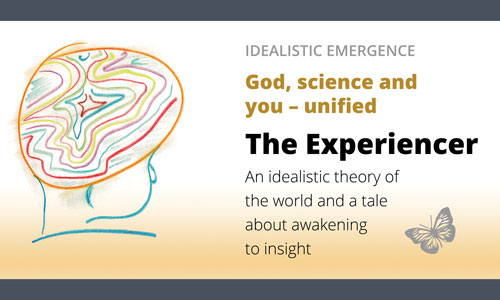Summary of the theory:
10.6. Experiencing takes time
The infinite spacetime Pattern is static.
Once formed, there is nothing that can later change it. As I said, so it is with abstract knowledge. Either it is there, or it is not there.
1 + 1 = 2 does not suddenly become 195.
1 + 1 = 2 can not just disappear either.
Nothing can be forgotten. How can one eliminate knowledge once it is established?
Yes, you as a human being can forget things, but now we are, for the time being, in the entirely abstract world of the universal Experiencer, and nothing abstract in this «everything» can disappear.
The Pattern that forms spacetime with its innumerable tiny variations arose in a single glimpse.
It took zero time because although the abstraction «time» was one of the first things that arose, it took the least conceptualisable time, the Planck time (5.391 x 10-44 seconds), until it was experienced.
All further emergence thus includes the notion, perception and experience of time, space and energy. All later interpretations are, therefore, consequences of time, have time as a raw material – and consequently take time.
On top of the static, eternal, fluctuating spacetime Pattern, new emerging notions are now formed, just as children see fabulous animals in the clouds. One notion follows the other, which becomes a third, fourth, fifth, etc.
Each of these notions is new, abstract knowledge in the awareness of the Experiencer that adds to the existing. It appears bit by bit as the conceptions are experienced as being somewhere in space and time.
What kind of concepts are we talking about?
They are all well known in physics: particles, mass and gravity, forces that affect the particles, electromagnetism, electric charge, etc. These are all microscopic «building blocks».
Gradually, notions of larger, complex things emerge. Some, by physics hitherto undiscovered particles, form quarks, which then form heavier particles (protons and neutrons) held together in a lump, a nucleus, by means of a force, the strong nuclear force. Next, atoms, molecules and elements are formed.
That turns into stones and body tissue – to simplify to an extreme degree.
At first, the information about these new things is abstract, conceptualised, thought of. At the same time, it must be experienced – because everything the Experiencer «imagines» is also experienced, as described in point 2.
Once a helium atom, for example, is conceptualised – the information does not disappear. Everything that later looks like a helium atom is understood as a helium atom, nothing else.
What is initially a mental, abstract notion is now also experienced as something physical in development, i.e. something that can be described with the physical laws we know in our seemingly material world.
The absolute beginning of this interpretation was experienced as «The Big Bang» – the whole infinite Pattern was suddenly there all at once. It had zero experienced extent, for distance is an interpretation of the Pattern. As an abstraction, it was everywhere, but as an experience, on the other hand, it was all in one point.
From there, it was all about emergence, which means «growth».
